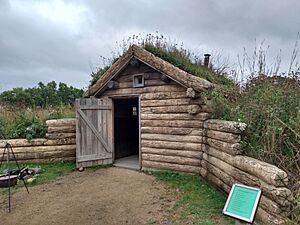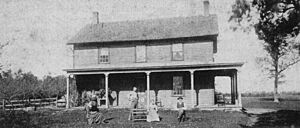Gibbs Museum of Pioneer and Dakotah Life facts for kids
Quick facts for kids |
|
|
Heman Gibbs Farmstead
|
|

The Heman Gibbs farmhouse in 2005
|
|
| Location | 2097 Larpenteur Avenue, Falcon Heights, Minnesota |
|---|---|
| Built | 1854 |
| Architectural style | Greek Revival |
| Website | http://www.rchs.com/gibbs-farm/ |
| NRHP reference No. | 75001009 |
| Added to NRHP | April 23, 1975 |
The Gibbs Farm is a special museum in Falcon Heights, Minnesota. It was once the home and farm of Heman and Jane Gibbs. They first built their farm in 1854. The main farmhouse you see today still includes their small, original cabin.
This museum helps visitors learn about life in Minnesota during the 1800s. You can discover what it was like for the pioneers who settled here. You also learn about the Dakota people who lived in southern Minnesota long before Europeans arrived.
In 1974, the Gibbs Farm was added to the National Register of Historic Places. This means it's an important historical site. The original farmhouse and barn are part of this historic listing. Other buildings at the museum were added later to help tell the story.
Contents
What You Can See at Gibbs Farm
The Gibbs Farm is an open-air museum. This means you can explore buildings and outdoor areas. It features the original farmhouse and barn. There's also a school house from that time.
You can also see cool replicas of old homes. These include a sod house, a bark lodge, and a tipi. Inside the tipi, you'll find copies of Dakotah furniture, clothing, and tools.
Exploring the Farmhouse
The objects inside the farmhouse are from the mid-1800s and later. They are part of the Ramsey County Historical Society's collection. You can see items that belonged to the Gibbs family during your tour.
Some interesting things include a family hair wreath. There's also original wallpaper and a hidden murphy bed. You'll find many other real items from the past.
Outdoor Adventures and Gardens
The museum grounds let you experience a natural Minnesota prairie. It looks much like it did in the 1800s. There's also a special Dakotah medicine teaching garden, called the turtle garden.
You can explore a Dakotah vegetable garden and a pioneer vegetable garden. There's even an old apple orchard and farm animals to meet.
Fun Programs and Events
The Gibbs Farm offers many exciting programs. These include summer camps and school tours. You can also visit during public hours on summer weekends.
A Look Back: The Gibbs Family Story
The museum shares the story of Jane Gibbs (her maiden name was DeBow). When she was about six or seven, she went to live with a missionary family called the Stevens. This was in 1833 near Batavia, New York. The Stevens family had lost their oldest daughter and took Jane in.
The Stevens family later brought Jane west with them. They were missionaries sent to teach Christianity to the Dakotah people. The Dakotah lived near Lake Calhoun (Bde Maka Ska) and Lake Harriet in what is now Minneapolis.
They arrived in May 1835 when Jane was about nine years old. Jane went to the missionary school. She learned to speak the Dakotah language with other children. She became very close to the Dakotah people. The women of the village gave her a special name: "Zitkadan Usawin," which means "Little Crow that was Caught." This name came from her story of leaving her mother.
Jane moved with the Stevens family, who treated her like their adopted daughter. They went to Southern Minnesota and then to Illinois. Jane later left them after Mrs. Stevens passed away. In 1848, she met and married Heman Gibbs in Galena, Illinois.
They returned to what was then the Minnesota Territory in 1849. That same year, they bought the land where the museum stands today.
The Dakota Trail and Annual Visits
Soon after buying their land, Jane and Heman found an old Indian trail. One fall day, they saw some of the same Dakotah people Jane had grown up with. The Dakotah were using the trail for their yearly journey north. They traveled to their wild rice, hunting, and fishing grounds near Forest Lake, Minnesota. The Gibbs' property was right where two of these trails met.
Every fall, the Dakotah group would set up camp at the Gibbs farm. They stayed for up to three weeks. They would visit with Jane and her family before continuing their journey.
Living in a Sod House
After buying their land in 1849, Jane and Heman Gibbs built a small, one-room home. It was a dugout sod house, often called the "Soddy." They lived there for five years while they farmed the land.
The house was about 10 by 12 feet. It was built with logs and had a roof made of sod (grass and soil). This design was clever! It kept the house warm in the winter and cool in the summer.
The original soddy was found to the right of the farmhouse's front porch in 1995. Today, a replica stands in the prairie. The spot where the real soddy was is now protected.
The Gibbs Family Farmhouse
In 1854, Jane and Heman built a one-room farmhouse. It was just a few steps from their sod house. This house stayed one room for 13 years. It was home to their five children: Ida (adopted), Abbie, William, Frank, and Lillie.
In 1867, the family needed more space. The house was made much bigger. The one-room house became an eight-room farmhouse! It was as large and modern as any in the area. The expanded house had a parlor (a living room). It also had six bedrooms, a room for hired workers, and a summer kitchen. The hired men's room is now a "farm lab" where visitors can try out old farm tools.
Learning at the Schoolhouse
Heman Gibbs was a well-educated man. He believed strongly in education for his own children and for others nearby. In 1871, he sold land across the street for a schoolhouse. While it was being built, he let classes be held in his farmhouse. The Gibbs family also let the teacher live in their home.
The schoolhouse you see at the museum today is not the exact one Heman helped build. The original one-room schoolhouse was used for many years. It even served as an extra classroom for growing schools in the 1950s.
The schoolhouse now at the museum was built near Milan, Minnesota. It was built around the same time as the original Gibbs schoolhouse. It shows what a typical pioneer one-room schoolhouse looked like. The Ramsey County Historical Society bought it in 1966 for $100. It had to travel about 140 miles (225 km) to the Gibbs Museum. The journey was carefully planned to avoid major roads and only happen during certain hours.
Images for kids
See also








